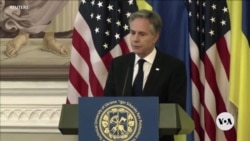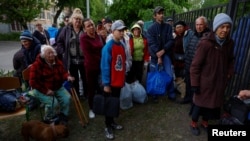U.S. Secretary of State Antony Blinken announced on Wednesday $2 billion in funding to finance Ukraine’s military efforts as he concluded his two-day visit to Kyiv.
The announcement comes as Ukrainian troops retreated in parts of the country’s northeast following heavy fighting with Russian forces.
On Wednesday, Russia said it seized two more settlements in the Kharkiv region, where Russian forces have been intensifying their offensive.
The Russian military also bombed Shevchenkivsky, the central district of Kharkiv, according to regional governor Oleh Syniehubov, who posted on Telegram that the attack injured two people and damaged a five-story building. The offensive prompted Ukrainian President Volodymyr Zelenskyy to postpone upcoming foreign visits.
Blinken also said Wednesday the United States knows the urgency of the situation in Ukraine, and that Ukrainian forces will be getting the support they need.
During a meeting with Ukrainian Foreign Minister Dmytro Kuleba in Kyiv, Blinken said U.S. President Joe Biden is working to deliver as quickly as possible a new round of aid authorized in late April.
The $2 billion arms deal will mostly draw from the U.S.’s $61 billion aid package for Ukraine, which was approved last month by Biden and Congress, a U.S. official said.
“I’m here in part as a show of support, but much more important than a trip or a visit is the fact that that support in very concrete terms is very much on the way,” Blinken said.
Kuleba said his country sees the U.S. stands by Ukraine, and that Ukraine “will be able to endure any hardships that Russia will try to impose on us.”
“This is a very timely visit, because it sends a message of encouragement not only to the people of Ukraine but most importantly to the troops, to our soldiers who are heroically defending Ukraine in the south, in the east, in the northeast near Kharkiv where Russia tries to expand the war zone,” Kuleba said.
Before their talks, Kuleba and Blinken laid wreaths at the Wall of Remembrance in Kyiv.
Russia’s defense ministry reported Wednesday destroying 10 missiles over Russia-occupied Crimea, as well as nine drones and multiple missiles over the western Russian region of Belgorod and several drones over both the Kursk and Bryansk regions.
Vyacheslav Gladkov, the regional governor of Belgorod, reported two people were injured and seven homes were damaged as a result of Ukrainian attacks.
Energy infrastructure targeted
The United Nations Office for the Coordination of Humanitarian Affairs (OCHA) said Tuesday that several waves of attacks in the Kharkiv region over the past few days have killed and injured numerous civilians, including children.
“These attacks have triggered yet more displacement from border and front-line communities,” OCHA’s Lisa Doughten told the U.N. Security Council. “As of today, authorities report that over 7,000 civilians were evacuated from border areas of the Kharkiv region.”
She said that since March, Russia has targeted Ukraine’s energy infrastructure, with the Kharkiv and Dnipro regions particularly affected. In April alone, the United Nations recorded 50 attacks that destroyed or damaged power generation plants and electricity substations, leaving millions across the country without power, water or cooking gas.
Doughten also expressed concern about what she said appears to be a new pattern of deadly attacks on railway infrastructure in Ukraine’s east and south, with 10 such attacks in April in government-controlled areas.
“And we are alarmed by reports of attacks damaging energy infrastructure and oil refineries in the Russian Federation,” Doughten added. “Such attacks risk inflaming the war further and worsening its humanitarian impacts.”
Moscow’s envoy dismissed the accusations, saying Russia’s air force carries out high precision strikes only on facilities related to Kyiv’s military capabilities. Vassily Nebenzia said life in Ukrainian cities is “proceeding normally, on the whole.”
VOA’s United Nations correspondent Margaret Besheer contributed to this report. Some information came from The Associated Press, Agence France-Presse and Reuters.











